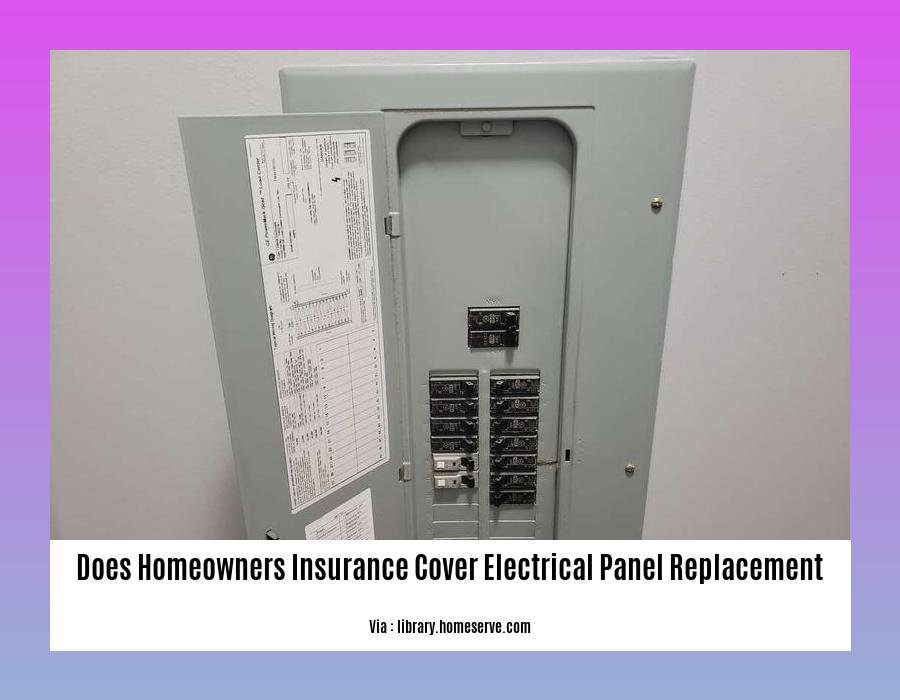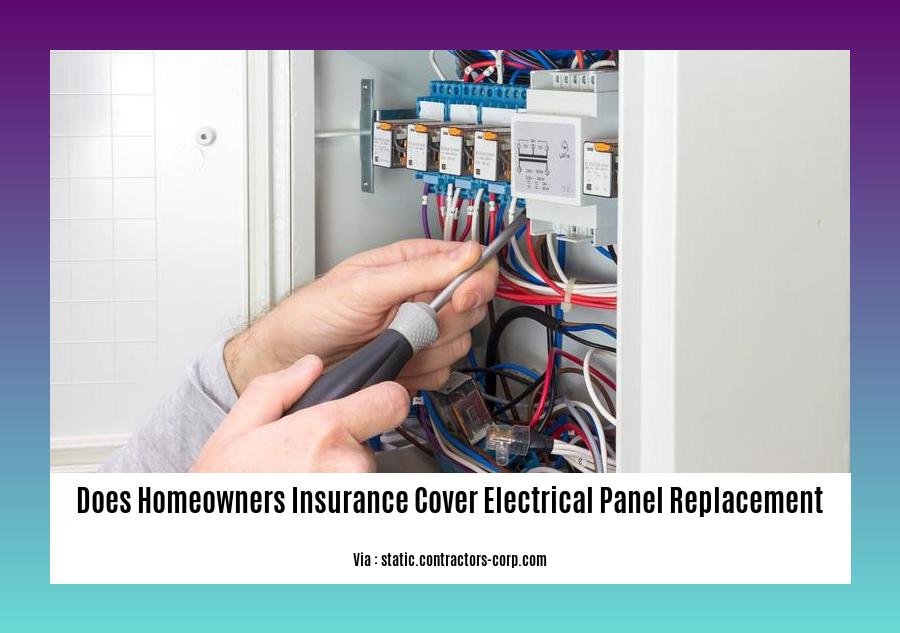Does Homeowners Insurance Cover Electrical Panel Replacement: A Comprehensive Guide for Homeowners to Understand Their Coverage Options
Key Takeaways:
-
Homeowners insurance coverage for electrical panel replacement varies depending on factors like the panel type, age, and adherence to electrical code specifications.
-
Standard insurance typically covers replacement costs if the panel is damaged by covered perils like fires, tornadoes, or hailstorms.
-
Repair or replacement costs are generally covered by insurance companies for panels damaged by covered perils.
-
The cost of replacing an electrical panel can range from $1,000 to $3,000, depending on its size and complexity.
-
Regular inspections and updates for older panels can help prevent damage and ensure coverage.
Does Homeowners Insurance Cover Electrical Panel Replacement?

Understanding Your Coverage Options
Electrical panel replacements can be costly, ranging from $1,000 to $3,000 or more. If an electrical panel fails due to a covered peril, homeowners insurance may offer financial protection. However, it’s crucial to understand the nuances of homeowners insurance coverage to navigate the claim process effectively.
What Does Homeowners Insurance Typically Cover?
Standard homeowners insurance policies generally cover electrical panel replacement if the damage is caused by a sudden and accidental event, such as:
- Fire
- Lightning
- Windstorm
- Hail
- Vandalism
- Theft
What is Not Covered by Homeowners Insurance?
Homeowners insurance policies typically exclude coverage for electrical panel replacement due to:
- Wear and tear
- Neglect
- Faulty installation
- Rodent damage
- Rust
- Corrosion
- Poor maintenance
Ensuring Coverage for Electrical Panel Replacement
To ensure coverage for electrical panel replacement, homeowners should:
- Regularly inspect the electrical panel for signs of damage or deterioration.
- Update the electrical panel if it is old or outdated to meet current electrical code specifications.
- Keep records of all electrical panel maintenance and repairs.
- Work with a qualified electrician for electrical panel installations, repairs, and maintenance.
Filing a Claim for Electrical Panel Replacement
If an electrical panel is damaged by a covered peril, homeowners should promptly notify their insurance company and follow these steps:
- Document the Damage: Take photos and videos of the damaged electrical panel and any surrounding damage.
- Contact a Qualified Electrician: Obtain a written estimate for the electrical panel replacement from a licensed electrician.
- File a Claim: Submit the claim to your insurance company, including the estimate, photos, and any other relevant documentation.
Conclusion
Homeowners insurance may cover electrical panel replacement under certain circumstances. However, it’s essential to understand the policy’s coverage, exclusions, and claim filing procedures to ensure a smooth and successful claim process. Regular maintenance, updates, and working with qualified electricians can help prevent electrical panel issues and minimize the need for costly replacements.
What does your homeowners insurance cover when you have electrical problems? Find out by clicking here.
Here is a useful article where you will find information about homeowners insurance and sewer line repair coverage.
Think you’re covered for asbestos issues? Look into it some more, click here and then check in with your insurance company.
If your homeowner’s insurance covers repairs, you should know about it. This article can get you started.
Limits and deductibles for electrical panel replacement
When it comes to homeowners insurance and electrical panel replacement, understanding the limits and deductibles is crucial. Electrical panel replacement coverage varies among insurance providers, and it’s essential to know what’s covered and what isn’t.
Covered perils:
In general, homeowners insurance typically covers electrical panel replacement if the damage is caused by:
- Sudden and accidental events like fire, lightning, windstorm, hail, vandalism, or theft.
Exclusions:
However, homeowners insurance typically excludes coverage for electrical panel replacement if the damage is caused by:
- Wear and tear.
- Neglect.
- Faulty installation.
- Rodent damage.
- Rust.
- Corrosion.
- Poor maintenance.
Limits:
Most homeowners insurance policies have a limit on the amount of coverage for electrical panel replacement. This limit varies from policy to policy, so it’s important to check your policy or talk to your insurance agent to find out what your limit is.
Deductibles:
When you file a claim for electrical panel replacement, you will be responsible for paying the deductible before your insurance company pays for the rest of the claim. The deductible is a set amount of money that you have to pay out of pocket before your insurance company starts to cover the costs of the claim. The amount of your deductible will vary depending on your insurance policy.
Key Takeaways:
-
Homeowners insurance typically covers electrical panel replacement if the damage is caused by sudden and accidental events like fire, lightning, windstorm, hail, vandalism, or theft.
-
Homeowners insurance typically excludes coverage for electrical panel replacement if the damage is caused by wear and tear, neglect, faulty installation, rodent damage, rust, corrosion, or poor maintenance.
-
Most homeowners insurance policies have a limit on the amount of coverage for electrical panel replacement.
-
When you file a claim for electrical panel replacement, you will be responsible for paying the deductible before your insurance company pays for the rest of the claim.
Filing a claim for electrical panel replacement

Navigating through the complexities of homeowners insurance coverage can be daunting, especially when it comes to understanding the extent of protection it provides for electrical panel replacements. In this guide, we’ll break down the key aspects to consider when filing a claim for electrical panel replacement, ensuring you have the knowledge and tools to safeguard your property and finances.
Key Takeaways:
-
Understand the terms and conditions of your homeowners insurance policy to determine the coverage provided for electrical panel replacements.
-
Document the damage thoroughly, taking photographs, and retaining receipts related to the repair or replacement.
-
Contact your insurance company promptly to report the claim and initiate the claims process.
-
Collaborate with a qualified electrician to assess the damage, provide a detailed estimate, and assist in the claims process.
-
Be prepared to provide additional documentation or information as requested by your insurance company to support your claim.
Understanding Your Coverage
The coverage provided for electrical panel replacements varies across insurance policies. Carefully review your policy to determine the specific terms and conditions that apply to your situation. Some policies may provide coverage for electrical panel replacement in cases of sudden and accidental damage caused by covered perils, such as lightning strikes, storms, or vandalism. However, coverage may be limited or excluded for damage resulting from wear and tear, lack of maintenance, or pre-existing conditions.
Documenting the Damage
Upon discovering damage to your electrical panel, promptly document the issue thoroughly. Take clear photographs of the damaged electrical panel from various angles, ensuring you capture the extent of the damage. Keep receipts and invoices related to the repair or replacement of the electrical panel, as they serve as essential documentation for your claim.
Filing the Claim
Contact your insurance company as soon as possible to report the damage and initiate the claims process. Provide the necessary information, including your policy number, contact details, and a brief description of the incident. Your insurance company will assign a claims adjuster to handle your case and guide you through the process.
Working with a Qualified Electrician
Collaborate with a qualified and licensed electrician to assess the damage to your electrical panel. The electrician can provide a detailed estimate of the repair or replacement costs, which is crucial for your insurance claim. Additionally, the electrician can assist in explaining the damage and its cause to the insurance company, strengthening your case.
Supporting Your Claim
Be prepared to provide additional documentation or information as requested by your insurance company to support your claim. This may include proof of ownership of the property, evidence of regular maintenance and upkeep of the electrical panel, and any relevant correspondence or reports related to the damage.
Conclusion
Filing a claim for electrical panel replacement involves understanding your insurance coverage, documenting the damage, promptly contacting your insurance company, working with a qualified electrician, and providing the necessary documentation to support your claim. By following these steps and staying informed about your policy’s terms and conditions, you can ensure a smooth and successful claims process, protecting your home and finances from unexpected expenses.
Sources
Additional considerations for electrical panel replacement coverage
Hey there, homeowners! If you’re wondering whether your insurance policy covers electrical panel replacement, you’re in the right place. Let’s dive into the nitty-gritty details and ensure you’re adequately protected.
Key Takeaways:
-
Electrical panel replacements can be costly, with expenses ranging from $1,000 to $3,000 or more.
-
Homeowners insurance offers coverage for electrical panel replacements caused by covered perils like fire, lightning, windstorm, hail, vandalism, or theft.
-
Wear and tear, neglect, faulty installation, rodent damage, rust, corrosion, or poor maintenance are typically excluded from coverage.
-
Regular inspections, updates, and working with qualified electricians can prevent electrical panel issues and costly replacements.
-
Notify your insurance provider promptly, document the damage, and obtain an estimate from a qualified electrician to file a claim for electrical panel replacement.
Factors Affecting Homeowners Insurance Coverage for Electrical Panel Replacement:
-
Peril causing the damage:
Standard policies cover sudden and accidental events like fire, lightning, windstorm, hail, vandalism, or theft. -
Condition and age of the electrical panel:
Older panels, known as Federal Pacific Electric (FPE) panels, pose safety hazards and may not be covered. -
Negligence and maintenance:
Neglecting regular inspections, repairs, and updates can void coverage. Working with qualified electricians is crucial. -
Policy terms and conditions:
Read your policy carefully to understand specific exclusions and limitations related to electrical panel coverage.
Steps to Ensure Coverage for Electrical Panel Replacement:
-
Regular Maintenance and Inspections:
Regularly inspect the electrical panel for signs of wear and tear, loose connections, or damage. Keep records of maintenance and repairs. -
Panel Updates and Upgrades:
Consider updating older panels to meet current safety standards and reduce the risk of accidents. Notify your insurance provider about any upgrades. -
Qualified Electricians:
Hire licensed and experienced electricians for all electrical work. This ensures proper installation, maintenance, and repairs, minimizing the risk of issues. -
Proper Documentation:
Document all electrical work, repairs, and upgrades with receipts and invoices. This documentation is essential for filing insurance claims. -
Prompt Claim Filing:
If your electrical panel is damaged, file a claim with your insurance company promptly. Provide detailed information about the damage, cause, and supporting documentation.
Remember, electrical panels are essential components of your home’s electrical system. Ensuring they are well-maintained, updated, and covered by your homeowners insurance is crucial to protect your property and avoid costly repairs.
References:
- Does Homeowners Insurance Cover Electrical Panel Replacement?
- Electrical Panel Upgrades That Homeowner’s Insurance Will Cover
FAQ
Q1: What are the typically covered perils under homeowners insurance for electrical panel replacement?
A1: Common covered perils include lightning strikes, fire, smoke, tornado, hail, windstorm, snow or ice, explosion, and theft.
Q2: Does homeowners insurance cover electrical panel replacement due to lack of maintenance or outdated systems?
A2: Generally, insurance companies may exclude coverage for damage caused by lack of maintenance or failure to update an older electrical system.
Q3: Can faulty electrical panels be covered by homeowners insurance?
A3: In rare cases, faulty electrical panel damage may be covered, but factors like the type, age, and condition of the panel influence coverage.
Q4: Why is replacing a faulty electrical panel important in terms of insurance coverage?
A4: Replacing faulty electrical panels helps protect homes from fire hazards and ensures compliance with insurance requirements.
Q5: Are there any specific electrical panel brands that have been recalled and may not be covered by homeowners insurance?
A5: Yes, certain electrical panel brands with safety concerns may not be covered under homeowners insurance. Regular inspections and evaluations by qualified electricians are recommended.
- Are Daffodils Perennials?A Complete Guide to Planting & Care - March 31, 2025
- Are Carpenter Bees Dangerous? Stings, Damage, and Control - March 31, 2025
- How to Get Rid of Ants in the Washroom: A Complete Guide - March 31, 2025










